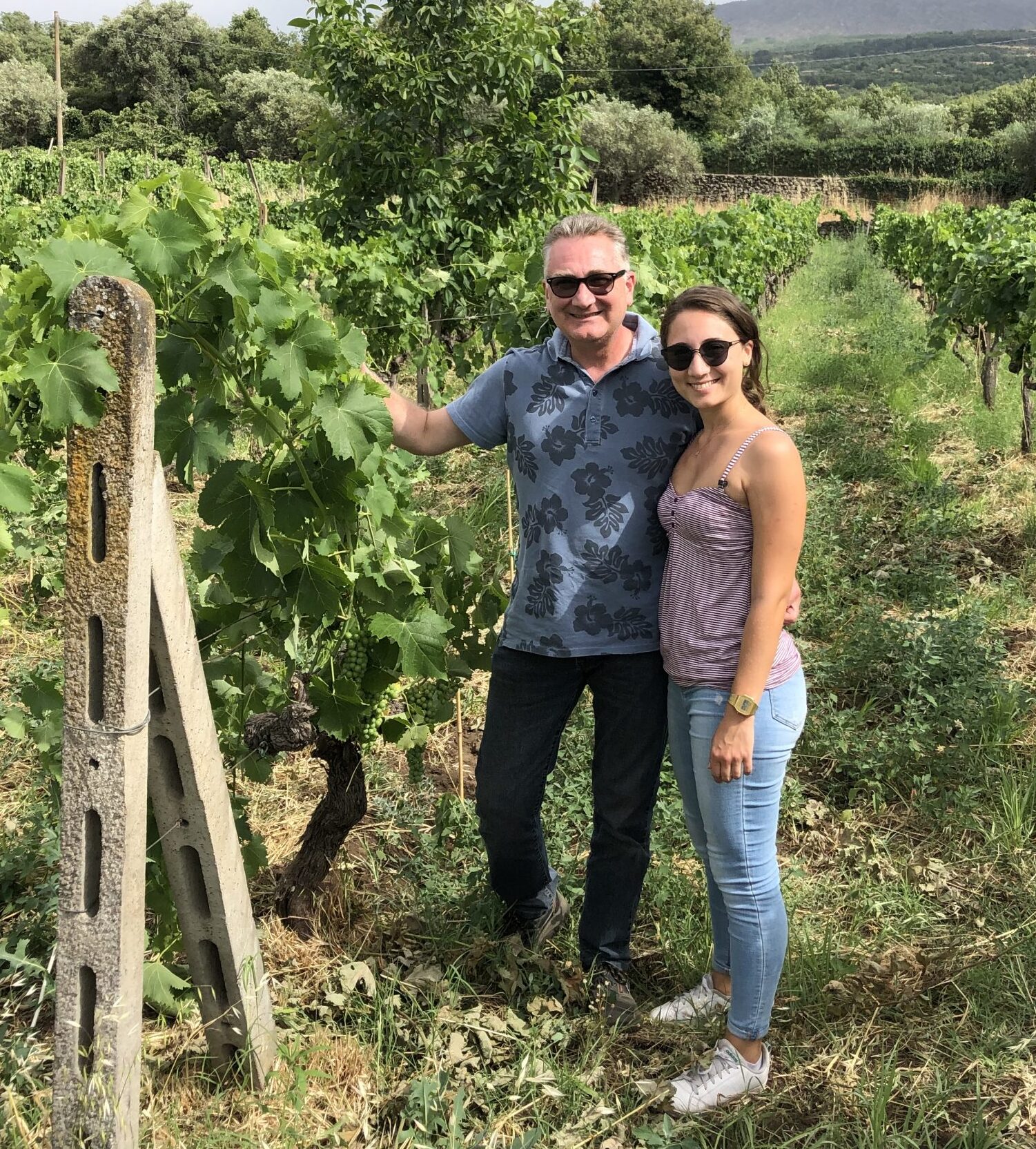- Antichi Vinai Nerello Mascalese (Sicily) $22
- Moulin Nouvel, Minervois 2021 (France) $20
- Funaro ‘Paso di Luna’ Inzolia/Zibibo (Sicily) $18
- Corazza Pinot Nero (Friuli, Italy) $19
- Mussio IGT Trevenezie Cab Fr. (Italy) $19
- Dom Felix 2023 Saint-Bris Sauvignon Blanc (France) $24
———————– (The 3-bottle Club Option) ———————–
1. Antichi Vinai 2021 ‘Sciare di Est’ Nerello Mascalese (Sicily) $22
A great discovery from a favorite region at a great price. We feel this is a great introduction to the red wines from Mt Etna. Is this the BEST wine we’ve ever tasted from Mt Etna? No, but it’s the best wine for the MONEY we’ve ever tasted. Go deep on this one.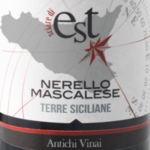
The Wine
This wine is 100% Nerello Mascalese from the family’s younger vines (5-15 years) located at lower elevation than the grapes reserved for their premier label. But this Nerello Mascalese still reflects the profile of their highly regarded, pricier Etna Rosso and serves as a good entry point to the volcanic wines of Mt. Etna.
Organic farming in sandy soils emphasizes the wine’s beautiful aromatics, which is then fermented and aged in Stainless Steel to allow highlight the wine’s primary aromatics and flavors – those contributed by the soil and the grape more than the winemaker.
Look for notes of bright red fruits, savory spices, a soft earthiness and supple tannins. Pair this wine with salmon salad, roasted chicken, soft cheeses and everyday meals such as pizza or burgers.
The Winery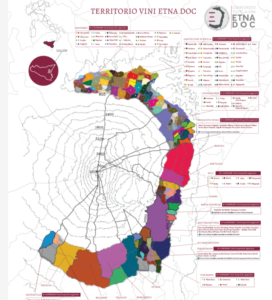
The Gangemi family began farming the volcanic slopes of Mount Etna back in 1877. After 147 years of experience on the mountain, it makes sense they are called Antichi Vinai (ancient vintners). During this time, the family has passed the helm to 5 generations, each adding their own unique contributions. It is currently led by Giuseppe Gangemi with his daughter, Viviana, as his protege. It seems the 6th generation is well-poised to take the family business forward for the next 40-50 years.
Most of Gangemi’s vineyards are located in the North and Northeastern parts of the volcano (the oldest soils) rising from 2,000 – 3,300 feet. Some of their Nerello Mascalese plantings are over 70 years old and their gnarled, rustic bush vines (untrellised) fit perfectly with the volcanic landscape of Etna.
With time honored respect to the land they practice organic farming, not just for the vines and the subsequent juice, but for the overall health of their land, supporting an array of wild fig and citrus trees in addition to vines.
The most active volcano in Europe, Mount Etna can wreak-havoc. On any given day the volcano is subject to an eruption, yet the Gangemi’s remain focused on their work. Their philosophy is that “Etna has always given more than it has taken”.
2. Moulin Nouvel, Minervois 2021 (France) $20
 Red wines from the Minervois in Languedoc-Roussillon offer affordable examples of good everyday wines.
Red wines from the Minervois in Languedoc-Roussillon offer affordable examples of good everyday wines.
In fact, when customers ask for a wine to pair with a simple, mid-week dinner, we often point these wines as prime examples of how affordable wine can be. While rarely are they low in alcohol (14%+ is the norm here), wines from Minervois, like those from most of Southern France, offer powerful wines of great complexity.
The herbaceous “garrigue” aromas common in the South of France are in evidence here, on top of fruit notes dominated by blue fruits and bramble berries. A powerful wine with good tannins and enough acidity to keep the wine from being tiring before the bottle is empty.
Pairs well with beef, veal, pasta and hard cheeses! Enjoy now through 2029.
The Minervois
Part of the larger Languedoc-Roussillon AOC, where regulations require the wine be a blend. And here things can get a bit tricky to understand:
60% of the blend must consist of one or more the following:
- Syrah
- Mourvedre
- Grenache
- Lladoner (a very obscure grape)
While the remaining 40% must be limited to:
- Carignan
- Cinsault
- Piquepoul
- and the very obscure Terret or Rivairenc
In the end, these blending requirements feature grapes that work well together, making a harmony of aromas and flavors that create enthusiastic advocates for this style of wine.
3. Funaro ‘Paso di Luna’ Inzolia/Zibibo (Sicily) $18
The Wine
97% Inzolia / 3% Zibibo (both of which are as much fun to say as they are to drink.
Straw yellow in color with light greenish hues. Intense aromas of exotic fruit and floral scents. Harmonious and delicate on the palate, with a mouth-watering freshness that makes it waaaay too easy to drink!
A mere 50 cases of this stellar wine come into the US each Spring, and by mid July they have long since been emptied, mostly by guests at various Michelin-awarded restaurants in Los Angeles and San Francisco. The always-increasing demand for this wine is not driven by Instagram hype, fashionable label design, or a skillful marketing campaign — it is is the result of bulletproof consistency and sky-high quality.
Sommeliers and retailers who know this wine vacuum up more and more each year, so, we’re very happy to have cornered a few cases for Farmstead.
Enjoy this wine chilled, alongside ahi crudo with lemon/olive oil/capers, a platter of oysters and/or grilled prawns, or even a cheeseburger. In our experience, it makes almost every meal taste better. And, over the years, we’ve also discovered this wine is a perfect candidate for homemade “wine coolers”.
We save the last 1/5 of the bottle, cut it with sparkling water or grapefruit La Croix, lots of ice, a small dash or simple syrup or sweet vermouth, and a generous slice of grapefruit or lime. Into the travel mug, and off you go for a walk up into Joaquin Miller or Tilden!
The Winery
Remember the first “Godfather” film? (If not, please stop reading this and immediately start streaming!) For those who have seen the iconic film, do you remember the scene in which a young, recently emigrated Michael Corleone first encounters his wife-to-be walking in a dry riverbed in rural Sicily?
While that scene was filmed in a remote, rural valley that just happens to be the site of the vineyard behind this delicious Sicilian white wine “Passo di Luna”.
The Funaro family’s gnarled, ancient, century-old grape vines (pre-phylloxera) grow in sand and crumbled volcanic rock. There is no aquifer for well water, so there is no choice but to dry farm. In this extremely dry and windy site, there is also (fortunately) no need for “crutches” like Roundup or systemic antifungals – and thus, the vineyard easily achieves organic certification every year.
Due to limited rainfall, the harvest is always small in volume, while the quality is undeniable: the Funaro family is renowned for exquisite farming and beautiful fruit. Each cluster seems destined to create perfectly lip-smacking, deeply refreshing, and deceptively complex white. The finished wine possesses both firm volcanic minerality, and vivid pomelo /honeysuckle /stone fruit aromatics.
It’s the ideal yin/yang balance between left brain “seriousness” and right brain hedonism; a platonic ideal Summer beach wine.
———————– (“6-bottle” Membership Option: all of above, plus…) ———————–
4. Corazza Pinot Nero (Friuli, Italy) $19
The Wine
Estate-bottled Friuli Pinot Nero from Patrick Corazza! A restaurant staple up and down the West Coast, this is lighter in body than the California examples, with unheard of complexity for the price.
In fact, this wine is lighter than our US versions, with more prominent acidity and freshness. These features make it perfect for most every situation that calls for wine, even to accompany fish dishes, which is often difficult to expect from a red.
Why would we include a Pinot Noir (Nero) from Italy, when France is so well known for this varietal? In short – value for your dollar!
The climate and soils in northern Italy’s Friuli region are well-suited to light red wines such as Pinot Noir. And this isn’t new knowledge – such grapes have a documented history that dates back many centuries.
OK, so these wines offer great value, a long growing history in this region, and… they’re versatile food wines!
Pair this wine with a wide array of foods, including richer fish dishes, Alpine cheeses, entree salads and the usual lamb/pork/chicken “Pinot triumvirate”.
5. Mussio IGT Trevenezie Cab Fr. (Italy) $19
The Wine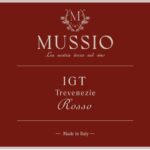
100% Cabernet Franc, the Mussio Rosso is a dry red wine from the Zoppola commune located in the region of Friuli Venezia Giulia, Italy. It is an IGT wine, meaning it has been judged to be typical of this region, which is to say the wine is herbaceous and fruity, with notable tannins and a lean profile.
The IGT is part of the three regions of Veneto, Friuli-Venezia-Giulia, and Trentino-Aldo-Adige, commonly referred to as Trevenezie (also Tre Venezia – the Three Venices of the old Venetian Empire).
The Winery
Giuseppe Mussio was born in the commune of Zoppola in Italy in 1894 in a very humble household. When World War One threatened the region of Friuli, Giuseppe was 13, he and other young people boarded a ship to the U.S.
Settling in San Francisco, he worked hard throughout the 1920’s and 30’s, and finally opened a restaurant called Bar Nevada that became a social gathering for other Italian Immigrants. After 40 years in America, Giuseppe decided to move back to his Friuli homeland and pursue his passion for Italian wines.
Today, Mussio wines still express the tenacious spirit of Giuseppe and the people of Friuli. Friuli is part of the region Friuli Venezia Giulia which in turn is within the IGT Delle Venezie.
6. Dom Felix 2023 Saint-Bris Sauvignon Blanc (France) $24
The Wine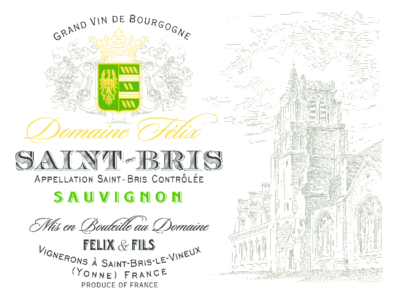
One of our favorite white wines for the money. Grown in the same limestone-rich soils as Chablis and Sancerre, the grapes for his wine produced a uniquely delicious take on Sauvignon Blanc.
From a cluster of small, truly ancient vineyards sprinkled across Burgundy’s northern extremities between Chablis and Auxerre, Domaine Felix’s individual wines are produced in limited volume and thus tightly allocated. The family has been farming the chalky limestone hillsides of Chablis, Irancy, Saint Bris, and Auxerre since 1692(!) and their calling card is award-winning, deeply mineral, lemony/green apple Sauvignon Blanc from the village of Saint Bris.
Pair with seafood, shellfish, goat cheese salad and most white cheeses, dishes featuring lemon flavors, or just as an aperitif.
The Winery
Only in the old world do we find a family history that reads “Burgundy is the home of the Felix family for several generations (1690)“. Since then, Domaine Felix has been passed down from generation to generation for over 300 years!
This particular appellation – Sain-Bris – is a relative newcomer to Burgundy appellations (2003). And it is an outlier by any measure – its vineyards are planted to Sauvignon Blanc and Sauvignon Gris, with Burgundy’s famed Chardonnay nowhere to be seen. Those who described Auxerre as “Burgundy’s other white grape” may have to reach into their bag of descriptors again. Perhaps not surprisingly, Saint-Bris is close to Auxerre. Birds of a feather…
The Sauvignon dominance becomes less eyebrow-raising when you look at a map and note that Saint-Bris is closer to Sancerre than to Beaune, the heart of Burgundy. And it shares the same soil composition as Sancerre, making things even less surprising – trying to grow a typical, Chard-dominated white Burgundy here would be sheer nonsense – the earth is telling the farmer something entirely different, and we should all be glad they listened when they planted their vineyards!


